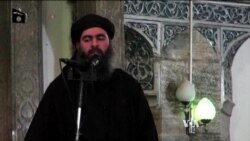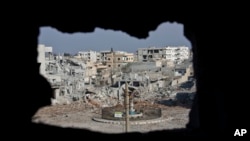Photos and video of Jordanian Air Force pilot Muath al-Kaseasbeh being burned alive at the hands of his Islamic State captors had U.S. officials searching for words, trying to describe another act of violence committed by a group that has continually found a way to shock the Western world.
But to those who have been closely following Islamic State, neither the level of violence nor the resulting drama is much of a surprise. Instead, it fits the pattern of a group that has acted with brutal effectiveness, while at the same time exposing potential weaknesses.
“Their priorities right now are really focused on burnishing their image to try to get themselves over that hump, to eclipse al-Qaida in the world of jihadism,” said Daveed Gartenstein-Ross, a senior fellow at the Foundation for Defense of Democracies.
Fostering and maintaining that image may be all the more important now, he said, “to make sure people are still flocking to and joining them despite the losses they’re incurring in Iraq and in Syria.”
Losing ground
The most notable of the Islamic State losses has been the northern Syrian town of Kobani.
Following a steady campaign of air strikes and a determined ground assault by Kurdish Peshmerga, IS lost its grip on the town at the end of January. Its fighters described the loss as a strategic retreat, on videos posted to the Internet.
The prolonged fight for Kobani took what would seems to be a heavy toll on IS, with U.S. military officials estimating the group lost more than 1,000 fighters to airstrikes alone. They said the combination of the strikes and the ground assault by Kurdish fighters also hit at Islamic State’s military capabilities.
“They’re being less battlefield effective,” said one senior defense official. “As they lose experienced fighters… they’re not leading as well.”
But none of that stopped Islamic State from continuing to pursue Kobani, continually sending in more fighters and supplies, presenting ample targets for U.S. and coalition warplanes.
For some, such a strategy is a sign that Islamic State’s weaknesses are beginning to surface.
“The likeliest explanation for why they keep pouring in resources even though it's so costly to try to take Kobani is the leader of the Islamic State, Abu Bakr al-Baghdadi, is personally invested in taking that territory. So, even though it doesn’t make strategic sense, they keep on trying,” Gartenstein-Ross said.
Islamic State’s goals
The focus on Kobani has, to some extent, puzzled U.S. military and intelligence officials.
Defense officials have said repeatedly that the Syrian town on the Turkish border is important only because Islamic State has made it important. One U.S. intelligence official said Islamic State wanted Kobani “real badly,” possibly as a border crossing or for its symbolic value.
Still, some military analysts warn that underestimating the militants would be a mistake.
“What ISIS [Islamic State] wants is a contiguous safe haven northeast of the Euphrates River,” said Christopher Harmer, a former U.S. Navy commander with the Institute for the Study of War.
“I think ISIS is fairly confident that the Turkish government doesn’t want to get involved in this fight. And so for the ISIS leadership it’s absolutely important, perhaps even imperative, that they establish this contiguous safe haven because once they do that they don’t sense that they’ll have any military threat from the Turkish side of the border.”
Harmer and other analysts argue that for a group like Islamic State, the human losses are almost irrelevant because it has shown the capacity to replenish its ranks with fresh foreign fighters and conscripts.
Abu Bakr al-Baghdadi
To Islamic State leader Baghdadi, the casualties, no matter how high, are likely a small price to pay in order to achieve his goal.
“Everything I see says he’s a careful, strategic thinker that is being rewarded for his dreams of glory,” said Dr. Jerrold Post, who runs the Political Psychology at the George Washington University.
Post founded the branch of the CIA that does behavioral analysis and has profiled numerous dictators.
He said it would be wrong to see Baghdadi as an impulsive, out-of-control madman. He said, if anything, Baghdadi is a malignant narcissist, a personality type exemplified by “extreme self-adoration,” a sense of paranoia, a lack of any conscience and what Post called “a willingness to use whatever aggression is necessary to forward his goals.”
They are many of the same traits exemplified by former Iraqi leader Saddam Hussein.
Possible cracks
Post said Baghdadi likely has weaknesses, including a tendency to overestimate his own popularity and a willingness to blame others. And while Post said Baghdadi clearly has made taken some missteps, he said they have yet to manifest in way that has hurt the Islamic State cause.
“I think to a significant degree he is capable of learning from experience, but his experience has been really quite positive.”
The continued flow of foreign fighters is a prime example.
Since the start of U.S. airstrikes, more than 4,000 foreign fighters have flocked to Syria and Iraq, with many joining Islamic State.
“That in itself is significant and a problem, because the Islamic State is very dependent upon foreign fighters,” said the Foundation for Defense of Democracies’ Daveed Gartenstein-Ross. “I think that there are signs, that in terms of their core numbers and zealous fighters for their cause, that they actually are strained but they’re making up for the reduced numbers.”













